While a symphony orchestra can have over one hundred musicians, some of the most powerful moments in orchestral music come from just fifteen or fewer players in the brass section. The brass section rests a lot during symphonies and film scores, but they usually dominate the music when they do play.
In order of the highest to lowest pitch, the brass section of an orchestra consists of trumpets, french horns, trombones, bass trombone, and the tuba. In this article, you will learn the essential elements of how these instruments work and when they are used.
Trumpet

First, we have the Trumpet, which like all brass instruments, produces sound by amplifying air blown into a mouthpiece that travels down a tube to a bell at the other end.
While the modern trumpet has a complicated design with piston valves for playing in every key, this design evolved slowly over time from much simpler beginnings.
By the end of the 19th century, chromatic trumpets were well established in the symphony orchestra.
A standard trumpet section has a maximum of four players, with the first player having the most critical role as principal trumpet.
The principal trumpet plays the highest notes of the trumpet section and is also responsible for any solos.
You can hear trumpet fulfilling many different roles in modern times ranging from militaristic fanfares to sweet lyrical melodies. But in general, the trumpet is almost always used during the most powerful moments in music.
Its loud volume and high range mean that you can always hear it.
While the standard trumpet section usually has either two, three, or four players, you will also discover some orchestral pieces that use more than that.
For example, in some Gustav Mahler symphonies, there are up to eight trumpets, including some that play offstage.
The Horn (French Horn)

The French Horn, often just called “the Horn” by modern players, is an instrument with an extended length of tubing coiled up into a circle.
The bell of the french horn is also large and wide. This larger bell gives the french horn a darker sound than the higher-pitched trumpet.
The terminology of the “French” horn probably comes from the origins of this instrument, which was as hunting horns in 16th century France and Germany.
Like the trumpet, the french horn evolved slowly over time from an instrument without valves – which means it could only play in one key – to one with valves that allowed it to play in every key.
A typical horn section will have four horn players, but smaller-scale pieces will have as few as two. Larger symphonies from composers like Gustav Mahler and Pyotr Ilyich Tchaikovsky can have eight or more horns.
If you would like to hear some powerful symphonic moments where the french horn section is featured, you can check out the following classic moments:
As you can see, when the horn section plays the same thing together – playing in unison – they create a powerful sound with depth and darkness that captures some of the most intense emotions in classical music.
Trombone

The trumpet and french horn both went through a pretty extensive evolution over the hundreds of years of western musical history.
The Trombone, while it has benefited from modern engineering, still has the same basic design that it always had.
The trombone originates from a renaissance instrument called a sackbut, for which the translation means “push/pull.” The pushing and pulling of the slide change the length of the instrument and create the range of musical keys possible on the trombone.
So when you are watching an orchestra concert, you can always pick out the trombone section by seeing the movement of the slides.
Trombones usually sit just to the left of or behind the trumpet section. This proximity allows the trumpets and trombones to blend naturally.
Compared to the trumpet, the trombone gets its lower and darker sound quality because the tubing is double the length of a trumpet. The mouthpiece size and bore size of the tubing are also much larger.
A standard trombone section consists of two trombones along with a third player on bass trombone which we’ll look at next.
Bass Trombone
The Bass Trombone differs from the previously discussed trombone – for which the full name would be tenor trombone – because the bass version of the trombone plays lower notes.
The bass trombone sits at the end of the trombone section and bridges the gap between them and the tuba.
Musical sounds are supposed to mirror the structure of a pyramid, with the lowest sounds providing a wide bass. This strong bass gives the higher instruments a foundation to put their sound on top of.
This reality about the physics of sound is why the bass trombone player occupies such a crucial role in the trombone section and the brass section more generally.
Tuba

And finally, the Tuba is the lowest brass instrument of the orchestra, and as such, it serves the role of the foundation of the brass section.
For a brass section to sound unified and in tune, the tuba player has to put out a solid and healthy sound, with plenty of overtones for the other brass players to fit inside of.
Together with the trombones and bass trombone, the tuba is a member of the low brass section. These players usually play simultaneously, unless there is a solo with only one of them playing.
Compared to older and more historical instruments like the trumpet and french horn, the tuba, invented in the mid-19th century, is a relatively new addition to the symphony orchestra.
While most orchestral pieces today will only require one tuba player, some situations use multiple tubas.
Conclusion
Hopefully, this exploration of orchestral brass instruments has given you a more detailed idea of how an orchestra makes the sounds it does.
As you study each instrument, you will learn to pick out their distinct sounds.
You will enjoy a more active and educated listening experience that allows you to appreciate the effort that goes into making a gorgeous orchestral piece come to life.


